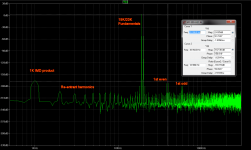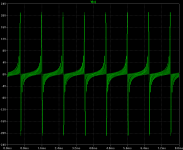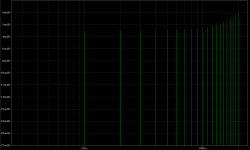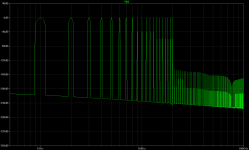So, I've been running a high-resolution IMD sim on my amp design, at 1W/8R output levels. Due to the high resolution, you'll get a clear view of what's produced; it's even more interesting to see that the IMD product itself also has its own harmonics (marked re-entrant in the image). These creep up all the way to the fundamentals in frequency, where they merge with the harmonics from the fundamentals themselves. It also shows that the IMD products are about the same level as the fundamental harmonics (what would be regarded THD with respect to these fundamentals).
It's easy to conclude that THD is indicative of IM, and as THD rises with higher frequency, it becomes clear, that IMD 'filth' appears in the most audible region (around 1K).
As for the amp itself, it's entirely made out of discrete components, no op-amps. All models used are Bob Cordell's models.
It's easy to conclude that THD is indicative of IM, and as THD rises with higher frequency, it becomes clear, that IMD 'filth' appears in the most audible region (around 1K).
As for the amp itself, it's entirely made out of discrete components, no op-amps. All models used are Bob Cordell's models.
Attachments
That is a superb result if the prediction is correct.
The input is the sum of the two test frequencies, i.e. +6dB relative to one frequency.
The worst IMD is ~-167dB.
Add on the 6dB and you are -173dB rel the test signal.
Maybe you also need to add on the 2.4dB shown as cursor 1, i.e. signal to highest IMD is >-175dB.
But the models are obviously "too good" and the real amplifier may realise nearer half that value for imd.
The input is the sum of the two test frequencies, i.e. +6dB relative to one frequency.
The worst IMD is ~-167dB.
Add on the 6dB and you are -173dB rel the test signal.
Maybe you also need to add on the 2.4dB shown as cursor 1, i.e. signal to highest IMD is >-175dB.
But the models are obviously "too good" and the real amplifier may realise nearer half that value for imd.
re #61 sim but thinking of music, if there were loads of 0dB fundamentals 1kHz apart, how high would the 1kHz IM product go?
That'll take me a while to set up and simulate, 20 sources, starting from 1K up to 20K at exactly 0 db. But I will try and see what I'll come up with. It'll be interesting though to see what the resulting 'ridge' above 0dB will look like.
Alrighty. The sim took ages, but I got it done. The result is not quite what I expected.
The first graph shows the wave form of 20 sources, evenly spaced from 1K to 20K.
The second graph shows the 'top' of the fundamentals. Before I started I calibrated the input to be exactly 0dB +- 100udB. Only at the end there is a little increase in amplitude, but otherwise it seems the individual amplitudes have dropped by ~ 3mdB. -Edit: It appears only the 20K fundamental has retained its original amplitude (0dB).
The 3rd graph shows the spectrum up to 100KHz, which shows a clear accumulation of the harmonics from all the fundamentals together.
I don't really know what conclusion to draw, other than that there may be cancellation / attenuation of the fundamentals by a small bit.
The first graph shows the wave form of 20 sources, evenly spaced from 1K to 20K.
The second graph shows the 'top' of the fundamentals. Before I started I calibrated the input to be exactly 0dB +- 100udB. Only at the end there is a little increase in amplitude, but otherwise it seems the individual amplitudes have dropped by ~ 3mdB. -Edit: It appears only the 20K fundamental has retained its original amplitude (0dB).
The 3rd graph shows the spectrum up to 100KHz, which shows a clear accumulation of the harmonics from all the fundamentals together.
I don't really know what conclusion to draw, other than that there may be cancellation / attenuation of the fundamentals by a small bit.
Attachments
Last edited:
Hi,
Logarithmically space your sources, 1K to 20K is +1.3 in logs.
so as 3 = 1K, 1.3/20 = 0.065, so next is 3.065, 1162Hz,
10 to the X of 3, 3.065, 3.13, 3.195, 3.26, ... up to 4.3.
You'll get a much better idea of IMD with those frequencies,
than using 20 linear spacing of 1KHz multiplles which overlap.
rgds, sreten.
Logarithmically space your sources, 1K to 20K is +1.3 in logs.
so as 3 = 1K, 1.3/20 = 0.065, so next is 3.065, 1162Hz,
10 to the X of 3, 3.065, 3.13, 3.195, 3.26, ... up to 4.3.
You'll get a much better idea of IMD with those frequencies,
than using 20 linear spacing of 1KHz multiplles which overlap.
rgds, sreten.
difference?
THD number of an integrated amp is not identical to the number on the datasheet of the used hybrid power amp IC.
THD of the STK-4151 may be under 0.1% at the rated power in 8R, no guarantee that the amp will too.
For an example : the cheapo 20W Akai AM-U110 from the early 1980s uses a 2-channel STK-461 IC.
The 461 is spec'd at a THD of 0.08% (20W continuous power in 8, 20Hz-20KHz)
THD of the integrated is 0.3% at the rated power.
(with the volume knob at half a watt continuous, even folks with tin ears will hear the distortion of that amp oozing off the edges of a half decent lsp)
Afair, the 4151/4152 aren't that far apart, ~1984/5.
(your M459 is from around 1990/1991, is my guess)
Personally, I'd doubt the 4152 datasheet number first, then the Akai spec.

If crossover distortion is a concern, then the THD number at full power is meaningless. Look for the THD numbers at 1W and below.
Is there a fundamental design difference between an amp whose THD increases approaching full power as opposed to one that decreases?
I think I haven't seen this question answered.
There isn't an amp where THD decreases approaching full power.
But during the first watts from zero it is normal to see THD decreasing until a few watts then increasing towards full power.
The crossover (class-B) distortion is considered one of the worst kind and its existence can probably be detected from first watt THD.
I'd say, if it stays below 0.001% THD20K under all circumstances, reactive loads and all. Then you at least can be assured, it should not be the amp that's causing any contribution of sound on its own. But that's my opinion. Chasing any lower THD is more like a sports. One I happen to love =)
That's a pretty high standard 😡
But even with such THD, I believe an amp can still contribute its share for the final sound.
I think I haven't seen this question answered.
There isn't an amp where THD decreases approaching full power.
Actually, a distortionless amplifier with a fixed noise floor in its output will exhibit decreasing THD+N right up to clipping. The reason is that there's no distortion, and the fixed noise level becomes proportionally smaller as the signal level through the amp is increased.
I'm not trying to be a jerk either - if you do distortion tests on amplifiers, you've probably noticed similar measurement phenomena with amplifiers whose THD+N is mostly noise…
Regards,
- Status
- Not open for further replies.
- Home
- Amplifiers
- Solid State
- How much THD is too much



